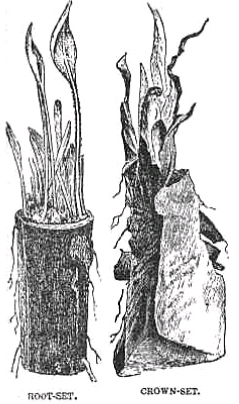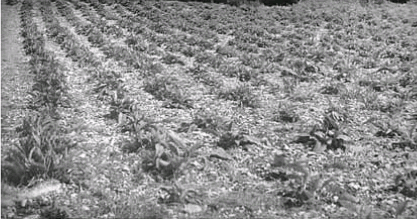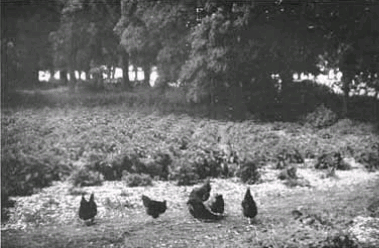
Growing comfrey
 Hopefully
you're sold by now and can think of at least one use for comfrey on your homestead. So
how do you grow it?
Hopefully
you're sold by now and can think of at least one use for comfrey on your homestead. So
how do you grow it?
Choose
a good location.
Comfrey isn't picky about soil quality, but it requires deep soil with
no hardpan, rock layer, or high water table to prevent the roots from
reaching
deep. Heavy clay is no problem, and is in fact preferred.
Although comfrey is moderately shade tolerant, it will be less
productive when planted out of the sun.
Propagate
your plants.
Comfrey is only grown from cuttings, so unless your pockets are deep
you will want to buy a few plants and then divide them up. The
good news is that one good-sized comfrey plant can be divided into
dozens of small plants, many of which can be harvested starting the
first
year. First dig up the large plant and cut off sections near the
top containing leaves --- each leaf crown area can become its own
plant. Then take all of the small roots that are left, cut them
into one inch sections, and plant them in a nursery bed one inch deep
and two inches apart. These youngsters can be transplanted into
permanent locations the next spring.
 Prepare your ground.
Comfrey will outcompete almost anything once it gets a foothold, but
you could lose your crop to weeds while it's getting established.
So take a bit of time to root out any perennial weeds.
Prepare your ground.
Comfrey will outcompete almost anything once it gets a foothold, but
you could lose your crop to weeds while it's getting established.
So take a bit of time to root out any perennial weeds.
Plant
your comfrey.
Comfrey needs a permanent location, much like an orchard, since it's
very difficult to eradicate once comfrey has gained a foothold on a
plot of
ground. Space plants three feet apart in good soil, or half that
in poor soil. Plant in the fall (September to November) or spring
(March to May.)
 Weed and
fertilize.
One tantilizing system consists of planting comfrey in the chicken
run. Since chickens don't like unwilted comfrey leaves, the birds
will weed
between the comfrey and fertilize it in the process, only requiring you
to add wood ashes or another form of potassium every few years to
balance the fertility. You can cut a plant or two every day while
feeding your chickens, and the poultry will eat up the cuttings the
next day once they're wilted. If you're not using chickens, dig
out any perennial weeds by hand and fertilize annually.
Weed and
fertilize.
One tantilizing system consists of planting comfrey in the chicken
run. Since chickens don't like unwilted comfrey leaves, the birds
will weed
between the comfrey and fertilize it in the process, only requiring you
to add wood ashes or another form of potassium every few years to
balance the fertility. You can cut a plant or two every day while
feeding your chickens, and the poultry will eat up the cuttings the
next day once they're wilted. If you're not using chickens, dig
out any perennial weeds by hand and fertilize annually.
Harvest. You can begin
cutting leaves as early as the first year, but the plants produce the
maximum yield
starting in the third year. After several more years,
productivity will
begin to decline as the centers of the huge comfrey plants die
out. This is the point at which you'll want to dig up the plants
and divide them, or just turn in pigs to root out the comfrey and start
a new comfrey patch elsewhere.
| This post is part of our Comfrey lunchtime series.
Read all of the entries: |
Want more in-depth information? Browse through our books.
Or explore more posts by date or by subject.
About us: Anna Hess and Mark Hamilton spent over a decade living self-sufficiently in the mountains of Virginia before moving north to start over from scratch in the foothills of Ohio. They've experimented with permaculture, no-till gardening, trailersteading, home-based microbusinesses and much more, writing about their adventures in both blogs and books.
Want to be notified when new comments are posted on this page? Click on the RSS button after you add a comment to subscribe to the comment feed, or simply check the box beside "email replies to me" while writing your comment.
- Remove comment
- Remove comment
